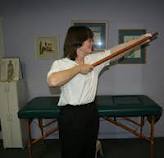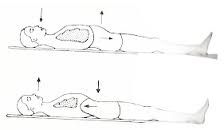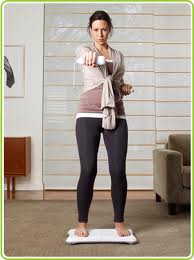When a portion of the lymphatic system is injured by trauma, surgery or radiation, or develops abnormally, the functionality of the lymphatic system is impaired. In many cases this can cause swelling, which most often affects the upper or lower extremities.
A well-balanced exercise program in combination with other treatment options used in the management for lymphedema is an important component to reduce the swelling, and a vital tool for patients to continue with normal activities of daily living.
Exercise protocols are customized by the lymphedema therapist and physician to meet individual goals for patients affected by lymphedema. The specific exercise protocols are determined by considering the stage and type of lymphedema, specific restrictions and limitations of joint and muscle activity, as well as additional medical conditions.
Decongestive Exercises
 Active, non-resistive and repetitive exercises are an important part in the treatment of lymphedema. Unlike the heart in the blood circulatory system, the lymphatic system does not have an active pump to propel lymphatic fluid back to the bloodstream. Effective lymph flow depends on sufficient muscle and joint activity, especially if the functionality of the lymphatic system is compromised. Decongestive exercises are most effective if performed with the patient wearing compression garments or bandages, which are also essential components in lymphedema management.
Active, non-resistive and repetitive exercises are an important part in the treatment of lymphedema. Unlike the heart in the blood circulatory system, the lymphatic system does not have an active pump to propel lymphatic fluid back to the bloodstream. Effective lymph flow depends on sufficient muscle and joint activity, especially if the functionality of the lymphatic system is compromised. Decongestive exercises are most effective if performed with the patient wearing compression garments or bandages, which are also essential components in lymphedema management.
Abdominal Breathing Exercises
 The downward and upward movement in diaphragmatic breathing is an important component for the sufficient return of lymphatic fluid back to the bloodstream. Patients affected by lymphedema of the leg benefit greatly from an exercise program including diaphragmatic breathing exercises. The movement of the diaphragm, combined with the outward and inward movements of the abdomen, rib cage, and lower back promotes general well-being, peristalsis and return of venous blood back to the heart.
The downward and upward movement in diaphragmatic breathing is an important component for the sufficient return of lymphatic fluid back to the bloodstream. Patients affected by lymphedema of the leg benefit greatly from an exercise program including diaphragmatic breathing exercises. The movement of the diaphragm, combined with the outward and inward movements of the abdomen, rib cage, and lower back promotes general well-being, peristalsis and return of venous blood back to the heart.
Resistive Exercises
 Exercises combined with resistance improve muscular power increase the strength in ligaments, tendons and bones. An additional benefit is their contribution to weight control. Resistive exercises are typically performed in a repetitive manner against an opposing load. Certain strength exercises are beneficial for lymphedema patients and should always be performed with the compression garment or bandage in place. Resistive exercises using inappropriate weights present a risk for injury or overuse and should be discussed with the treating therapist and physician.
Exercises combined with resistance improve muscular power increase the strength in ligaments, tendons and bones. An additional benefit is their contribution to weight control. Resistive exercises are typically performed in a repetitive manner against an opposing load. Certain strength exercises are beneficial for lymphedema patients and should always be performed with the compression garment or bandage in place. Resistive exercises using inappropriate weights present a risk for injury or overuse and should be discussed with the treating therapist and physician.
Aerobic Exercises
 Aerobic conditioning is generally performed in a repetitive fashion using large muscle groups. Some long-term benefits include decrease in resting heart rate, improved muscular strength, weight control and increased return of venous and lymphatic fluids. It is important to understand that certain aerobic exercises and recreational activities could trigger an increase in swelling and should be avoided by patients affected by lymphedema. Examples of these high-risk activities include soccer, kick-boxing or step-aerobics for lower extremity lymphedema, and tennis or golf for lymphedema affecting the arms. Beneficial activities include swimming, walking, water-aerobics, easy biking or yoga.
Aerobic conditioning is generally performed in a repetitive fashion using large muscle groups. Some long-term benefits include decrease in resting heart rate, improved muscular strength, weight control and increased return of venous and lymphatic fluids. It is important to understand that certain aerobic exercises and recreational activities could trigger an increase in swelling and should be avoided by patients affected by lymphedema. Examples of these high-risk activities include soccer, kick-boxing or step-aerobics for lower extremity lymphedema, and tennis or golf for lymphedema affecting the arms. Beneficial activities include swimming, walking, water-aerobics, easy biking or yoga.
Aquatic Exercises
 The buoyancy effect water has on the musculo-skeletal system makes movement more comfortable. Range of motion and flexibility are increased when in a warm water pool and the cardiovascular system is working more effectively, so an aerobic workout is possible. Additionally, the hydro static pressure acts like a “full-body garment” and helps to reduce swelling. Exercises in the water geared toward the treatment of lymphedema are resistive, assistive/supportive, compressive, relaxing and comforting.
The buoyancy effect water has on the musculo-skeletal system makes movement more comfortable. Range of motion and flexibility are increased when in a warm water pool and the cardiovascular system is working more effectively, so an aerobic workout is possible. Additionally, the hydro static pressure acts like a “full-body garment” and helps to reduce swelling. Exercises in the water geared toward the treatment of lymphedema are resistive, assistive/supportive, compressive, relaxing and comforting.
Dear Lymphedema Blog Reader – if you like the contents on this website, please help to keep it going. A great amount of work and research is necessary to provide you with up-to-date information on this site. Your donation supports these efforts and associated administrative costs. Surplus funds will be donated to Lymphedema/Lipedema-related charitable endeavors. Please donate using the “Donate Now” button on the right upper hand of this page – Thank You!
Join Lymphedema Guru, a Facebook page solely dedicated to inform about all things related to lymphedema – news, support groups, treatment centers, and much more


 Joachim Zuther, Lymphedema Specialist.
Joachim Zuther, Lymphedema Specialist. 

What is your position on the use of vibration plates
(Power Plate etc) to facilitate lymph drainage. My understanding is that patients are weight bearing on these plates while they exercise and it is not a stationary use of the plates.
We do not recommend performing exercises while on a vibration plate
what exercises are there for lymphedema in the legs
Thank you very much, Vince
Look at this article, approximately in the middle: https://www.lymphedemablog.com/2011/01/06/decongestive-and-breathing-exercises-for-lymphedema/
Really like the website